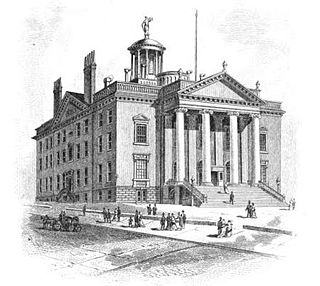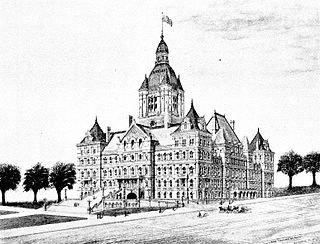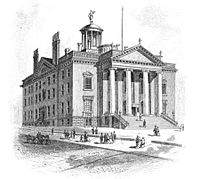Background
Under the provisions of the New York Constitution of 1821, 32 Senators were elected on general tickets in eight senatorial districts for four-year terms. They were divided into four classes, and every year eight Senate seats came up for election. Assemblymen were elected countywide on general tickets to a one-year term, the whole Assembly being renewed annually.
On May 13, 1845, an "Act recommending a Convention of the people of this State" was passed, submitting at the next State election to the people the question whether they wanted to call a convention to amend the State Constitution. At the State election in November 1845, the question was answered in the affirmative. The Constitutional convention met from June 1 to October 9, 1846. The amended Constitution abolished rotative renewal of the Senate, required all legislators to be elected in single districts, made the State cabinet offices elective by popular ballot, and made major changes in the judicial system. The new Constitution was submitted to the electorate at the next State election for ratification.
On March 30, 1846, the Legislature re-apportioned the Assembly districts: Chautauqua, Chenango, Columbia, Cortland, Madison, Ontario and Wyoming counties lost one seat each; Albany, Erie, Kings and St. Lawrence counties gained one seat each; and New York City gained three seats. The total number of assemblymen remained 128. [2]
On May 13, 1846, the Legislature re-apportioned the Senate districts: Kings County was transferred from the 1st to the 2nd District; Ulster County from the 2nd to the 3rd District; and Schenectady County from the 3rd to the 4th District. [3]
At this time there were two major political parties: the Democratic Party and the Whig Party. The Democratic Party was split into two factions: the "Barnburners" and the "Hunkers." The radical abolitionists appeared as the Liberty Party. The Anti-Rent Party nominated some candidates, but mostly cross-endorsed Whigs or Democrats, according to their opinion on the rent issue.
The Whig state convention met on September 23 at Utica, and nominated Assemblyman John Young for Governor; and Hamilton Fish for Lieutenant Governor.
The Democratic state convention met on October 1 at Syracuse, and nominated Gov. Silas Wright and Lt. Gov. Addison Gardner for re-election.
The Anti-Rent state convention met in October at Beardsley's Hotel in Albany, and endorsed John Young (W) for Governor; and Lt. Gov. Addison Gardiner (D) for re-election.
The Native American state convention nominated Ogden Edwards for Governor; and State Senator George Folsom for Lieutenant Governor.
The Liberty state convention nominated Henry Bradley for Governor and William L. Chaplin for Lieutenant Governor.
Sessions
The Legislature met for the regular session at the Old State Capitol in Albany on January 5, 1847; and adjourned on May 13.
William C. Hasbrouck (W) was elected Speaker with 71 votes against 50 for J. Lawrence Smith (D).
On February 12, Albert Lester (D) was elected president pro tempore of the State Senate, to preside during the absence of Lt. Gov. Gardiner.
On June 7, the 1847 New York special judicial election, was held to fill the judicial offices elective under the new State Constitution, for example the judges of the New York Court of Appeals, the justices of the district benches of the New York Supreme Court, county judges, surrogates, district attorneys etc. Lt. Gov. Gardiner was elected to the Court of Appeals. State Senators Ira Harris and Augustus C. Hand; and Assemblyman William B. Wright were elected to the Supreme Court.
On July 5, Lt. Gov. Gardiner took office on the Court of Appeals, and President pro tempore Albert Lester became Acting Lieutenant Governor.
The Legislature met for a special session on September 8, 1847; and adjourned on December 15.
On September 27, the Legislative passed "An Act to provide for the election of a Lieutenant Governor", to fill the vacancy at the next State election.
On November 15, the Legislature elected Thomas Clowes (W) as a Canal Commissioner, to fill the vacancy caused by the resignation of Nathaniel Jones (D). [4]

The 1st New York State Legislature, consisting of the New York State Senate and the New York State Assembly, met from September 9, 1777, to June 30, 1778, during the first year of George Clinton's governorship, first at Kingston and later at Poughkeepsie.

The 2nd New York State Legislature, consisting of the New York State Senate and the New York State Assembly, met from October 13, 1778, to March 17, 1779, during the second year of George Clinton's governorship, at Poughkeepsie.

The 44th New York State Legislature, consisting of the New York State Senate and the New York State Assembly, met from November 7, 1820, to April 3, 1821, during the fourth year of DeWitt Clinton's governorship, in Albany.

The 45th New York State Legislature, consisting of the New York State Senate and the New York State Assembly, met from January 2 to April 17, 1822, during the fifth year of DeWitt Clinton's governorship, in Albany.

The 58th New York State Legislature, consisting of the New York State Senate and the New York State Assembly, met from January 6 to May 11, 1835, during the third year of William L. Marcy's governorship, in Albany.

The 63rd New York State Legislature, consisting of the New York State Senate and the New York State Assembly, met from January 7 to May 14, 1840, during the second year of William H. Seward's governorship, in Albany.

The 64th New York State Legislature, consisting of the New York State Senate and the New York State Assembly, met from January 5 to May 25, 1841, during the third year of William H. Seward's governorship, in Albany.

The 65th New York State Legislature, consisting of the New York State Senate and the New York State Assembly, met from January 4 to September 7, 1842, during the fourth year of William H. Seward's governorship, in Albany.

The 66th New York State Legislature, consisting of the New York State Senate and the New York State Assembly, met from January 3 to April 18, 1843, during the first year of William C. Bouck's governorship, in Albany.

The 67th New York State Legislature, consisting of the New York State Senate and the New York State Assembly, met from January 2 to May 7, 1844, during the second year of William C. Bouck's governorship, in Albany.

The 68th New York State Legislature, consisting of the New York State Senate and the New York State Assembly, met from January 7 to May 14, 1845, during the first year of Silas Wright's governorship, in Albany.

The 69th New York State Legislature, consisting of the New York State Senate and the New York State Assembly, met from January 6 to May 13, 1846, during the second year of Silas Wright's governorship, in Albany.

The 71st New York State Legislature, consisting of the New York State Senate and the New York State Assembly, met from January 4 to April 12, 1848, during the second year of John Young's governorship, in Albany.

The 76th New York State Legislature, consisting of the New York State Senate and the New York State Assembly, met in Albany from January 4 to July 21, 1853, during the first year of Horatio Seymour's governorship.

The 84th New York State Legislature, consisting of the New York State Senate and the New York State Assembly, met from January 1 to April 16, 1861, during the third year of Edwin D. Morgan's governorship, in Albany.

The 86th New York State Legislature, consisting of the New York State Senate and the New York State Assembly, met from January 6 to April 25, 1863, during the first year of Horatio Seymour's second tenure as Governor of New York, in Albany.

The 90th New York State Legislature, consisting of the New York State Senate and the New York State Assembly, met from January 1 to April 20, 1867, during the third year of Reuben E. Fenton's governorship, in Albany.

The 91st New York State Legislature, consisting of the New York State Senate and the New York State Assembly, met from January 7 to May 6, 1868, during the fourth year of Reuben E. Fenton's governorship, in Albany.

The 92nd New York State Legislature, consisting of the New York State Senate and the New York State Assembly, met from January 5 to May 11, 1869, during the first year of John T. Hoffman's governorship, in Albany.

The 117th New York State Legislature, consisting of the New York State Senate and the New York State Assembly, met from January 2 to April 27, 1894, during the third year of Roswell P. Flower's governorship, in Albany.




